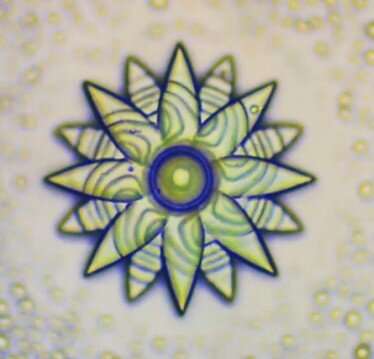Researchers develop 3-D printing substrate with dynamic bonds for adjustable properties

Fantastic shapes can be made using 3-D printing, but for many applications the material used needs to be much stronger than what is currently available. This is something that chemists in Eindhoven are working on: "The material used by the current generation of 3-D printers is similar to spaghetti. We're making spaghetti that sticks together like Velcro."
"The research we are doing is somewhat generic, whereas in Maastricht it is more application based. That is evident from their presentations, which feature images of animals that have been cut open," says Hans Heuts. His voice betrays a mild sense of horror, causing his colleague Rint Sijbesma to laugh out loud. Not a single drop of blood runs from their own research at the chemistry faculty of the Eindhoven University of Technology, even though it is ultimately applied in the 3-D printing of prosthetics and implants. There is an area where they and their Maastricht colleagues do have something in common, though: the groups of researchers are both developing new plastics and gels based on dynamic chemical bonds. These are chemical compounds in a substance that easily separate and yet easily rebond.
Dynamic bonds ensure that the properties of the substance are able to change during or after their production. "We are working on stronger materials for 3-D printing," explains Sijbesma. "The gels being made in Maastricht are intended for use on humans, for introducing stem cells into the body, for example." A third research project is also underway in Eindhoven as part of the joint DYNAM research program. Chemist Albert Schenning is working on 4-D printing. He is developing materials that react to external signals, such as light. "You can make very precise shapes by exposing the material to light," says Sijbesma. DYNAM is a research program in which the two universities are working in partnership with DSM, Brightlands Materials Center, the Netherlands Organisation for Applied Scientific Research, and Xilloc, a young made-to-measure medical implants company. The Xilloc website has eye-catching images of 3-D-printed parts of skulls, one of the applications that come to mind with medical 3-D printing.
New printing materials
It is possible to create shapes using 3-D printing that cannot easily be made with traditional methods—an example is that of two seamlessly interlinked hooks. No molds are needed either, which is useful for objects that are unique or custom-made implants or prosthetics. Chemists Sijbesma and Heuts are developing new materials for laser sintering, a printing technique in which layers of powder are melted together into an object with the help of laser. "The high level of precision is fantastic, and you don't need a support surface as you do with other 3-D printing methods," says Heuts, "but the result is nowhere near as strong as with injection molding, for example."
Sijbesma and he are therefore working on new plastics that will allow the melted powder to attach more effectively. "Normal polymers are kind of like spaghetti strands, which attach because they become entangled with each other. We are improving their adhesive strength by adding dynamic bonds. That's when you get what we call Velcro spaghetti," explains Heuts. At high temperatures, the Velcro bonds separate and the plastic is liquefied. Sijbesma: "As a result, it is easy to work with at high temperatures." Once it has cooled off, the material is rock solid.
The research is going well. Multiple new materials are being created in the lab. "You try out all kinds of things that you think might work," says Sijbesma. Sometimes things work out well, other times less so. "One of the materials we made actually turned out to be extremely brittle." Colleagues from the Department of Mechanical Engineering are currently testing the best materials. Heuts continues: "They are looking at whether the powders flow 'neatly' into each other when heated up." This does not mean that Sijbesma and Heuts' work is done. "If, for example, an otherwise highly promising material does not melt at the right temperature, then we have to start working where we left off."
Extruder
Consideration also has to be given to the right production method. An extruder will shortly be arriving—a piece of equipment widely used in the plastic chemicals sector. This is a type of syringe into which plastic grains enter on one side, and from which melted plastic comes out from the other. "The starting point for our research is that we use simple chemistry and extensively used starting materials," Heuts emphasizes. "The basis we use is a DSM commercial polyester. We add another substance to that to create the dynamic bonds." Using the extruder, he would like to see whether this mixing works on a larger scale. "With a bit of luck, we will put our starting materials into the extruder and our new plastic will come out as a liquid," he says. If this does indeed happen, the step towards commercial use would be greatly simplified. Sijbesma: "At present, we are only using small quantities of powder, a few grams, but I don't believe upscaling should be a problem."
The strong materials have been specially designed for 3-D printing, but could also be used in other areas. Repairable plastic, for example. "It flows when you heat it up, and is strong when it cools down. You could therefore repair a breakage by heating up the plastic," explains Heuts. "It is still speculation, but it could be used for repairing wind turbines."
"Or children's plastic toys," adds Sijbesma, "so that you wouldn't have to throw them away whenever a piece breaks." For now, this is all just speculation, of course, and Sijbesma and Heuts have more pressing matters on their minds. First, they want to achieve what they promised in their research proposal—develop a strong material for 3-D printing. "Until we've done that, all the rest is just noise."




















